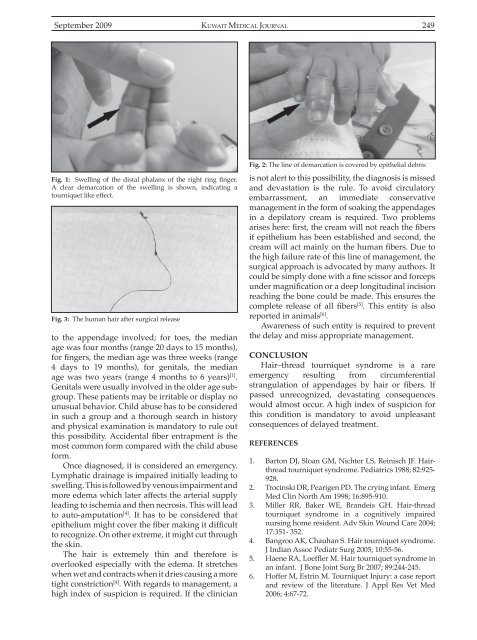Vol 41 # 3 September 2009 - Kma.org.kw
Vol 41 # 3 September 2009 - Kma.org.kw
Vol 41 # 3 September 2009 - Kma.org.kw
You also want an ePaper? Increase the reach of your titles
YUMPU automatically turns print PDFs into web optimized ePapers that Google loves.
<strong>September</strong> <strong>2009</strong><br />
KUWAIT MEDICAL JOURNAL 249<br />
Fig. 1: Swelling of the distal phalanx of the right ring finger.<br />
A clear demarcation of the swelling is shown, indicating a<br />
tourniquet like effect.<br />
Fig. 3: The human hair after surgical release<br />
to the appendage involved; for toes, the median<br />
age was four months (range 20 days to 15 months),<br />
for fingers, the median age was three weeks (range<br />
4 days to 19 months), for genitals, the median<br />
age was two years (range 4 months to 6 years) [1] .<br />
Genitals were usually involved in the older age subgroup.<br />
These patients may be irritable or display no<br />
unusual behavior. Child abuse has to be considered<br />
in such a group and a thorough search in history<br />
and physical examination is mandatory to rule out<br />
this possibility. Accidental fiber entrapment is the<br />
most common form compared with the child abuse<br />
form.<br />
Once diagnosed, it is considered an emergency.<br />
Lymphatic drainage is impaired initially leading to<br />
swelling. This is followed by venous impairment and<br />
more edema which later affects the arterial supply<br />
leading to ischemia and then necrosis. This will lead<br />
to auto-amputation [4] . It has to be considered that<br />
epithelium might cover the fiber making it difficult<br />
to recognize. On other extreme, it might cut through<br />
the skin.<br />
The hair is extremely thin and therefore is<br />
overlooked especially with the edema. It stretches<br />
when wet and contracts when it dries causing a more<br />
tight constriction [4] . With regards to management, a<br />
high index of suspicion is required. If the clinician<br />
Fig. 2: The line of demarcation is covered by epithelial debris<br />
is not alert to this possibility, the diagnosis is missed<br />
and devastation is the rule. To avoid circulatory<br />
embarrassment, an immediate conservative<br />
management in the form of soaking the appendages<br />
in a depilatory cream is required. Two problems<br />
arises here: first, the cream will not reach the fibers<br />
if epithelium has been established and second, the<br />
cream will act mainly on the human fibers. Due to<br />
the high failure rate of this line of management, the<br />
surgical approach is advocated by many authors. It<br />
could be simply done with a fine scissor and forceps<br />
under magnification or a deep longitudinal incision<br />
reaching the bone could be made. This ensures the<br />
complete release of all fibers [5] . This entity is also<br />
reported in animals [6] .<br />
Awareness of such entity is required to prevent<br />
the delay and miss appropriate management.<br />
CONCLUSION<br />
Hair–thread tourniquet syndrome is a rare<br />
emergency resulting from circumferential<br />
strangulation of appendages by hair or fibers. If<br />
passed unrecognized, devastating consequences<br />
would almost occur. A high index of suspicion for<br />
this condition is mandatory to avoid unpleasant<br />
consequences of delayed treatment.<br />
REFERENCES<br />
1. Barton DJ, Sloan GM, Nichter LS, Reinisch JF. Hairthread<br />
tourniquet syndrome. Pediatrics 1988; 82:925-<br />
928.<br />
2. Trocinski DR, Pearigen PD. The crying infant. Emerg<br />
Med Clin North Am 1998; 16:895-910.<br />
3. Miller RR, Baker WE, Brandeis GH. Hair-thread<br />
tourniquet syndrome in a cognitively impaired<br />
nursing home resident. Adv Skin Wound Care 2004;<br />
17:351- 352.<br />
4. Bangroo AK, Chauhan S. Hair tourniquet syndrome.<br />
J Indian Assoc Pediatr Surg 2005; 10:55-56.<br />
5. Haene RA, Loeffler M. Hair tourniquet syndrome in<br />
an infant. J Bone Joint Surg Br 2007; 89:244-245.<br />
6. Hoffer M, Estrin M. Tourniquet Injury: a case report<br />
and review of the literature. J Appl Res Vet Med<br />
2006; 4:67-72.
















